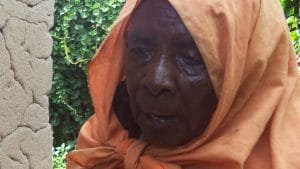Growing up in a family of traditional healers in Musamo Village, Ruhango District, Rwanda, Karuhimbi saw the ethnic violence escalating in 1959 between the Hutu majority and the Tutsi, perhaps better known in the west as the Watusi. The revolution, which continued until 1962, replaced the Tutsi monarchy with a new Hutu-led government. In 1959, as troops were approaching, she told the mother of a young Tutsi boy to put beads in his hair, “and not put him down, so the militia would think he looked like a girl when they saw him,” she said years later — “because they only killed boys at that time.” The boy survived. Meanwhile, violence continued, escalating into the Rwandan Civil War in 1990. The war culminated in genocide when in April 1994, the government ordered the army to annihilate the Tutsi — including women and children. Over about 100 days, an estimated 70 percent of the Tutsi were killed — approximately 800,000 people. Karuhimbi sheltered as many as she could in her modest family home.

Karuhimbi, from a Hutu family herself, played on the Hutu troops’ superstitions: they thought she was a witch doctor, so “Zura told Interahamwe militia if they entered the shrine, they would incur the wrath of Nyabingi” (a Kinyarwanda word for God), remembers Hassan Habiyakare, one of the people she shielded. “They were frightened and our lives were saved for another day.” The ruse was aided by her knowledge of traditional medicines. “She would also anoint herself with a local skin-irritating herb and could touch the killers to try to keep them away,” says Jean Pierre Bucyensenge, a journalist. It’s unknown exactly how many people she shielded in her house: at least 100, and perhaps more than 150, and “If they are to die, I die with them,” Karuhimbi vowed. “I remember one Saturday, they came back again,” she said in 2014. “I confronted them as usual, warning them that by killing the refugees in my house, they were digging their own graves.” It worked: none of the people she shielded, including babies who had been snatched from their dead mothers, were killed in the massacre. But her own children were not in the home: her son and daughter were killed.

“I am not a witch doctor,” she confirmed in 2014. “I only believed in one God and the thing of magical power was just an invention and cover I was using to save lives.” Karuhimbi was revered in Rwanda for her courage. In 2006 President Kagame awarded her the Umurinzi — the Kinyarwanda word for “guard” or “protector” — and the name for the Rwandan Campaign against Genocide Medal. It’s unclear how old Karuhimbi was; her Rwandan identity card listed her birth as 1925, making her 93. Others in her village said she was “well over” 100. She died — of natural causes — in her same house, on December 17. “She risked her life to save others,” says Bucyensenge. “Her story is a reminder that humanity prevails, even in the most difficult situations.”
